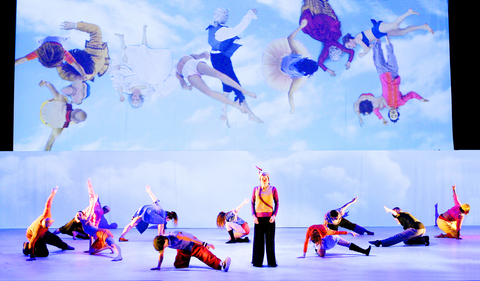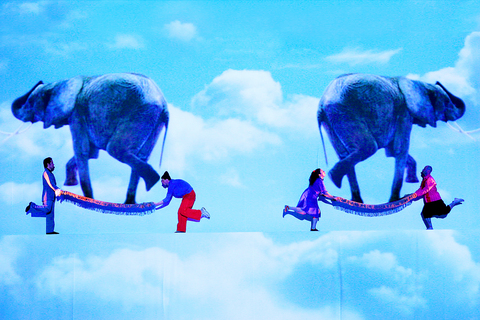A veritable Noah's Ark accompanied France's Compagnie Montalvo-Hervieu as the troupe returned to the Taipei stage last night with their surreal On Danse, a unique blend of circus, dance and video that is almost guaranteed to have audiences bopping in their seats and fighting the urge to get up and dance themselves.
The company, founded in 1985 by Jose Montalvo, the group's conceptual artist, and Dominique Hervieu, the associate choreographer, was last seen in Taipei in 1998, with their production Paradise.
Like Paradise, On Danse is dance-theater: a clever blend of multimedia and live dance, as an endless parade of life-size animals — and some larger than life — gallop, walk and prowl across the back of the stage.

Sometimes there are real humans mixed in with this virtual zoo, like the man who appears to be carrying an oversized white cockatoo on his wrist. Just a man taking his pet bird out for a walk — what could so strange about that? Perhaps it is that the bird appears to be larger than the man.
Horses, zebras, lions, Bactrian camels, storks, baby elephants appear and disappear — not to mention the two baby chicks large enough to give those with alektorophobia nightmares for weeks.
The upper level of the split-level screen shows an array of clouds floating by. Sometimes there are animals amid the clouds and sometimes the sky is filled humans bouncing around like they are playing on a celestial trampoline; other times there are cupids falling through the air as if they have been expelled from paradise.

PHOTOS: COURTESY OF COMPAGNIE MONTALVO-HERVIEU
Just like at a three-ring circus, sometimes it's hard not to get distracted by all the animals to the point where you ignore the show that's right in front of you, in this case, Montalvo-Hervieu's amazingly gifted troupe of young dancers who whirl through a joyous blend of ballet, jazz, African dance, hip-hop and even some belly-dancing.
The smiles are certainly real enough; as are the "see if you can top this" looks the dancers sometimes give one another.
The company is based in the multi-ethnic Parisian suburb of Creteil, and that diverse world is reflected in the make-up of the troupe. It's another Noah's Ark with dancers of varying shapes, sizes, colors and dance backgrounds, but the world they create on stage is a dizzying celebration of both diversity and the melting pot.
The fast-paced choreography, with its very modern flair, is set to, of all things, the Baroque opera melodies of the 18th-century French composer Jean-Phillipe Rameau. It's another example of Montalvo and Hervieu's very own world, made out of different genres that should be clashing, not blending together.
Montalvo and Hervieu have been quoted as saying they were first struck by Rameau's spirit of sheer joy when they worked on a production of his opera Les Paladins at the Theater du Chatelet in Paris.
"Rameau bends the rules, in a spirit of sheer jubilation," Montalvo is quoted as saying in the program notes. "His music is a hymn to 'present joys.'"
In Rameau, Montalvo and Hervieu certainly have found a kindred spirit, whose energy, imagination, sense of humor and love of fantasy matches their own, despite the centuries that divide them.

The canonical shot of an East Asian city is a night skyline studded with towering apartment and office buildings, bright with neon and plastic signage, a landscape of energy and modernity. Another classic image is the same city seen from above, in which identical apartment towers march across the city, spilling out over nearby geography, like stylized soldiers colonizing new territory in a board game. Densely populated dynamic conurbations of money, technological innovation and convenience, it is hard to see the cities of East Asia as what they truly are: necropolises. Why is this? The East Asian development model, with

June 16 to June 22 The following flyer appeared on the streets of Hsinchu on June 12, 1895: “Taipei has already fallen to the Japanese barbarians, who have brought great misery to our land and people. We heard that the Japanese occupiers will tax our gardens, our houses, our bodies, and even our chickens, dogs, cows and pigs. They wear their hair wild, carve their teeth, tattoo their foreheads, wear strange clothes and speak a strange language. How can we be ruled by such people?” Posted by civilian militia leader Wu Tang-hsing (吳湯興), it was a call to arms to retake

This is a deeply unsettling period in Taiwan. Uncertainties are everywhere while everyone waits for a small army of other shoes to drop on nearly every front. During challenging times, interesting political changes can happen, yet all three major political parties are beset with scandals, strife and self-inflicted wounds. As the ruling party, the Democratic Progressive Party (DPP) is held accountable for not only the challenges to the party, but also the nation. Taiwan is geopolitically and economically under threat. Domestically, the administration is under siege by the opposition-controlled legislature and growing discontent with what opponents characterize as arrogant, autocratic

When Lisa, 20, laces into her ultra-high heels for her shift at a strip club in Ukraine’s Kharkiv, she knows that aside from dancing, she will have to comfort traumatized soldiers. Since Russia’s 2022 invasion, exhausted troops are the main clientele of the Flash Dancers club in the center of the northeastern city, just 20 kilometers from Russian forces. For some customers, it provides an “escape” from the war, said Valerya Zavatska — a 25-year-old law graduate who runs the club with her mother, an ex-dancer. But many are not there just for the show. They “want to talk about what hurts,” she